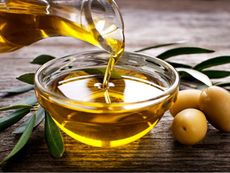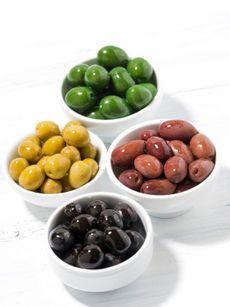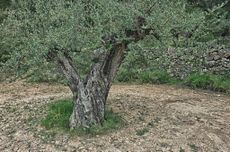Olive Tree Pests – Learn About Bud Mites On Olive Trees


Olive tree pests can be a real problem, especially if you’re counting on your tree to produce lots of fruit. The olive bud mite is one of these problems, though it’s not as big a problem as you might think. Keep reading to learn more about mites on olive trees and olive bud mite treatment.
What are Olive Bud Mites?
What are olive bud mites? They’re little creatures that measure about 0.1-0.2 millimeters long – too small to see with the naked eye. Under a microscope, you can see that they’re yellow, teardrop shaped, and four legged. They live and feed exclusively on olive trees. Since you can’t see them, the best way to tell if you have olive bud mites is to look for the damage caused by them. This can appear in the form of prematurely dropped flowers or buds, discolored buds, stunted growth, or spotty leaves that curl under. In very young olive trees, a bad infestation can seriously stunt the plant’s growth.
Olive Bud Mite Treatment
So how do you go about controlling olive tree mites? In most cases, you don’t. Even a large infestation isn’t likely to hurt the tree or affect olive harvest too much. The only reason to take action is if your harvest has been below average for several years running. If this is the case, you can apply powdered or wettable sulfur. (Don’t apply the wettable variety on days hotter than 90 F./32 C.). You can also try non-chemical approaches, such as introducing ladybugs, a natural predator. If you live in Australia, there are some predatory mites that feed on them but, unfortunately, they’re not native anywhere else in the world.
Gardening tips, videos, info and more delivered right to your inbox!
Sign up for the Gardening Know How newsletter today and receive a free download of our most popular eBook "How to Grow Delicious Tomatoes."

The only child of a horticulturist and an English teacher, Liz Baessler was destined to become a gardening editor. She has been with Gardening Know how since 2015, and a Senior Editor since 2020. She holds a BA in English from Brandeis University and an MA in English from the University of Geneva, Switzerland. After years of gardening in containers and community garden plots, she finally has a backyard of her own, which she is systematically filling with vegetables and flowers.
-
 How To Get Rid Of Mosquitoes In The Garden: 9 Natural Ways To Make Them Buzz Off!
How To Get Rid Of Mosquitoes In The Garden: 9 Natural Ways To Make Them Buzz Off!How to get rid of mosquitoes is on the minds of people in the summer in almost every region of the world. Learn how to repel the pests without toxic chemicals.
By Mary Ellen Ellis
-
 Monkey Orchid Care: How To Grow This Fascinating Species
Monkey Orchid Care: How To Grow This Fascinating SpeciesThe monkey orchid (Dracula simia) bears a remarkable resemblance to its namesake and, with a little know-how, can be successfully grown as a houseplant.
By Bonnie L. Grant
-
 How To Press Olive Oil: Making Olive Oil At Home
How To Press Olive Oil: Making Olive Oil At HomeInterested in making oil from olives? It's easier than you might think. Click here to learn how to press olive oil.
By Amy Grant
-
 Olive Tree Appetizer: Creating A Christmas Tree Made Of Olives
Olive Tree Appetizer: Creating A Christmas Tree Made Of OlivesA Christmas tree made of cheese and colorful olives is something you’ll want to try. Click here for tips on making an olive Christmas tree.
By Mary H. Dyer
-
 Olive Preservation Guide: How Do You Brine Olives
Olive Preservation Guide: How Do You Brine OlivesCured olives are a delicious snack or addition to recipes. There are many methods for curing olives. Learn how to preserve olives here.
By Bonnie L. Grant
-
 Growing An Olive Tree With No Olives: What Is A Fruitless Olive Tree
Growing An Olive Tree With No Olives: What Is A Fruitless Olive TreeWhat is a fruitless olive tree, you may ask? Many are not familiar with this beautiful tree, commonly used for its beauty in the landscape. The olive tree with no olives may be the perfect tree for your southern landscape. Click this article to learn more about fruitless olives.
By Becca Badgett
-
 Olive Tree Xylella Disease: Learn About Xylella Fastidiosa And Olives
Olive Tree Xylella Disease: Learn About Xylella Fastidiosa And OlivesIs your olive tree looking scorched and not thriving as it should. Perhaps, Xylella disease is to blame. What is Xylella? This bacterial disease affects hundreds of different plants and trees in temperate climates around the world. Click here to learn how it affects olives.
By Mary H. Dyer
-
 Olive Oil Information: Learn How To Use Olive Oil
Olive Oil Information: Learn How To Use Olive OilOf course, we know how to use olive oil with foods, but have you ever wondered about olive oil?s other uses? There are, indeed, other uses for olive oil. The following article contains information about what exactly olive oil is and how to use olive oil beyond cooking.
By Amy Grant
-
 Olive Tree Topiaries – Learn How To Make An Olive Topiary
Olive Tree Topiaries – Learn How To Make An Olive TopiaryOlive trees are native to the Mediterranean region of Europe. They have been grown for centuries for their olives and the oil they produce. Olive tree topiaries are popular. If you are considering making an olive tree topiary, the following article will help.
By Teo Spengler
-
 Olive Houseplants – Growing A Potted Olive Tree Indoors
Olive Houseplants – Growing A Potted Olive Tree IndoorsOlive trees as houseplants? If you?ve ever seen mature olives, you may wonder how it?s possible to transform these reasonably tall trees into olive houseplants. But it is not only possible, indoor olive trees are the latest houseplant craze. Learn more here.
By Teo Spengler